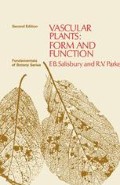Abstract
Descriptions of meristems bring up a number of questions. One wonders why the cells in the meristematic region should be continually dividing while many other tissues of the plant contain cells that divide at most only rarely. Why do meristems form at various times and places on the plant? Is a meristem capable of producing an entire plant even though it might be separated from the plant that it has already produced? Basically, one might ask how important the environment is in determining the expression of a meristem’s developmental potential. Most of these problems await future research for their complete solution, but we have fairly complete answers to at least one of them (the third, above) and have made significant headway with the others. In this chapter we will discuss some of the physiological findings relating to meristems and the differentiation of the cells that are produced by meristems.
Preview
Unable to display preview. Download preview PDF.
Author information
Authors and Affiliations
Copyright information
© 1970 Wadsworth Publishing Company, Inc., Belmont, California
About this chapter
Cite this chapter
Salisbury, F.B., Parke, R.V. (1970). Differentiation. In: Vascular Plants: Form and Function. Fundamentals of Botany Series. Palgrave, London. https://doi.org/10.1007/978-1-349-00364-8_6
Download citation
DOI: https://doi.org/10.1007/978-1-349-00364-8_6
Publisher Name: Palgrave, London
Print ISBN: 978-0-333-05468-0
Online ISBN: 978-1-349-00364-8
eBook Packages: Biomedical and Life SciencesBiomedical and Life Sciences (R0)

